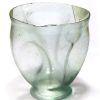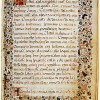Up to now it has been impossible to establish precisely when the Venice glassmaking industry first began. One of the likely theories links its earliest production to the period when the Veneto people moved to the estuary islands after having lived in flourishing Roman coastal towns on the Adriatic (from Adria to Altino) and where they had learned Roman glassmaking techniques.
A document witnessed by a notary dating from 982 was signed by a certain Domenico who was a “fiolario”, that is he made blown glass, mainly producing bottles known as “fiole”. The only evidence of Venetian glassmaking consists of fragments found in 1961-62 together with the remains of a furnace during excavations in the “Piazza” of Torcello. Fragments have also been discovered in the Murano subsoil ( the church of San Donato) as well as in the lagoon itself.
More recently, between 1992-93 during excavations at Malamocco ( a small place on the Lido), some ceramic fragments certainly dating from between the end of the 4th and the beginning of the 5th century were brought to light, together with two truncated cone-shaped beakers and a rounded long-necked bottle dating from the same period as those on display in this room. During the 12th-14th centuries the art of glassmaking certainly developed through contact with East, particularly Syria, Egypt and the Eastern Roman Empire as a consequence of wars and commercial enterprises.
As is documented, it is certain that from the last 20 years of the 13th century until about the mid – 14th century there was the art of anamelling on glass in Murano (Gregorio da Napoli, Bartolomeo da Zara, Donino). In the 13th century the glassmakers had a statute drawn up in latin which laid down the regulations that controlled the activities of the guild. In 1441 it was rewritten in the vernacular and was called the “Mariegola dell’Arte dei Verieri de Muran”. In the Mariegola (or Matricola” there were rules which covered all the phases of glassmaking – from production to selling, taxes and the relations between the owners, glass masters and other workers in the factory.



